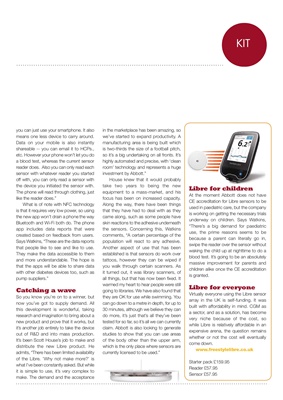
KITKIT
you can just use your smartphone. It also
means one less device to carry around.
Data on your mobile is also instantly
shareable -- you can email it to HCPs.,
etc. However your phone won't let you do
a blood test, whereas the current sensor
reader does. Also you can only read each
sensor with whatever reader you started
off with, you can only read a sensor with
the device you initiated the sensor with.
The phone will read through clothing, just
like the reader does."
What is of note with NFC technology
is that it requires very low power, so using
the new app won't drain a phone the way
Bluetooth and Wi-Fi both do. The phone
app includes data reports that were
created based on feedback from users.
Says Watkins, "These are the data reports
that people like to see and like to use.
They make the data accessible to them
and more understandable. The hope is
that the apps will be able to share data
with other diabetes devices too, such as
pump suppliers."
Catching a wave
So you know you're on to a winner, but
now you've got to supply demand. All
this development is wonderful, taking
research and imagination to bring about a
new product and prove that it works, but
it's another job entirely to take the device
out of R&D and into mass production.
It's been Scott House's job to make and
distribute the new Libre product. He
admits, "There has been limited availability
of the Libre. 'Why not make more?' is
what I've been constantly asked. But while
it is simple to use, it's very complex to
make. The demand and the acceptance
in the marketplace has been amazing, so
we've started to expand productivity. A
manufacturing area is being built which
is two-thirds the size of a football pitch,
so it's a big undertaking on all fronts. It's
highly automated and precise, with 'clean
room' technology and represents a huge
investment by Abbott."
House knew that it would probably
take two years to being the new
equipment to a mass-market, and his
focus has been on increased capacity.
Along the way, there have been things
that they have had to deal with as they
came along, such as some people have
skin reactions to the adhesive underneath
the sensors. Concerning this, Watkins
comments, "A certain percentage of the
population will react to any adhesive.
Another aspect of use that has been
established is that sensors do work over
tattoos, however they can be wiped if
you walk through certain scanners. As
it turned out, it was library scanners, of
all things, but that has now been fixed. It
warmed my heart to hear people were still
going to libraries. We have also found that
they are OK for use while swimming. You
can go down to a metre in depth, for up to
30 minutes, although we believe they can
do more, it's just that's all they've been
tested for so far, so it's all we can currently
claim. Abbott is also looking to generate
studies to show that you can use areas
of the body other than the upper arm,
which is the only place where sensors are
currently licensed to be used."
Libre for children
At the moment Abbott does not have
CE accreditation for Libre sensors to be
used in paediatric care, but the company
is working on getting the necessary trials
underway on children. Says Watkins,
"There's a big demand for paediatric
use, the prime reasons seems to be
because a parent can literally go in,
swipe the reader over the sensor without
waking the child up at nighttime to do a
blood test. It's going to be an absolutely
massive improvement for parents and
children alike once the CE accreditation
is granted.
Libre for everyone
Virtually everyone using the Libre sensor
array in the UK is self-funding. It was
built with affordability in mind. CGM as
a sector, and as a solution, has become
very niche because of the cost, so
while Libre is relatively affordable in an
expensive arena, the question remains
whether or not the cost will eventually
come down.
Starter pack £159.95
Reader £57.95
Sensor £57.95